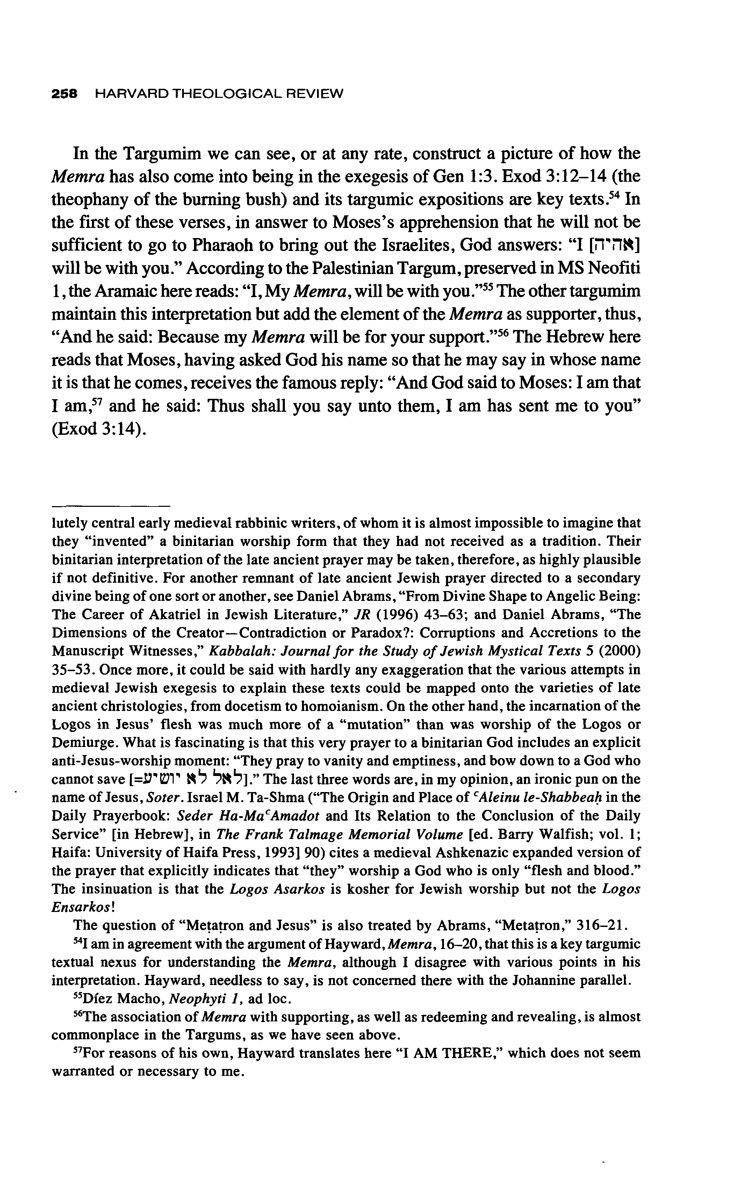or second divine beings.
Moreover, there is powerful evidence that in quite early (but post-Christian) mystical
prayer even among rabbinic circles, it was possible to pray to both "The Lord of All" and the
"Creator of BereDshit," without this having, seemingly, any "gnostic" meanings. Idei uses the term "binitarian" for this form of Jewish prayer in its early medieval manifestations and
explicitly rejects the terminology of "gnosis" that had appeared in earlier scholarly writings
(Moshe Idei, "Prayer in Provencal Kabbalah" [in Hebrew] Tarbiz 62 [1993] 269). This form of Jewish prayer may be as early as the late second century, and at the latest is from the fourth-fifth centuries. (For discussion of dating as well as references to earlier literature, see Michael
D. Swartz, "Λ/ay Le-Shabbeah: a Liturgical Prayer in Macaseh Merkabah," JQR 87 [1986-87]
186 n. 21). Scholem dated the prayer very early (Gershom Scholem, Jewish Gnosticism,
Merkabah Mysticism and Talmudic Tradition [2d ed.; New York: Jewish Theological Seminary of America, 1965] 27). It is thus at least contemporary with the later targumic texts. It becomes harder and harder to see binitarian worship as the distinguishing feature between
"Judaism" and "Christianity." As Idei emphasizes, this binitarian prayer was found in abso-

2 5 8 HARVARD T H E O L O G I C A L REVIEW
In the Targumim we can see, or at any rate, construct a picture of how the
Memra has also come into being in the exegesis of Gen 1:3. Exod 3:12-14 (the
theophany of the burning bush) and its targumic expositions are key texts.54 In
the first of these verses, in answer to Moses's apprehension that he will not be
sufficient to go to Pharaoh to bring out the Israelites, God answers: "Ι [ΠΤΤΑ]
will be with you." According to the Palestinian Targum, preserved in MS Neofiti
1, the Aramaic here reads: "I, My Memra, will be with you."55 The other targumim
maintain this interpretation but add the element of the Memra as supporter, thus,
"And he said: Because my Memra will be for your support."56 The Hebrew here
reads that Moses, having asked God his name so that he may say in whose name
it is that he comes, receives the famous reply: "And God said to Moses: I am that
I am,57 and he said: Thus shall you say unto them, I am has sent me to you"
(Exod 3:14).
lutely central early medieval rabbinic writers, of whom it is almost impossible to imagine that
they "invented" a binitarian worship form that they had not received as a tradition. Their
binitarian interpretation of the late ancient prayer may be taken, therefore, as highly plausible
if not definitive. For another remnant of late ancient Jewish prayer directed to a secondary
divine being of one sort or another, see Daniel Abrams, "From Divine Shape to Angelic Being:
The Career of Akatriel in Jewish Literature," JR (1996) 43-63; and Daniel Abrams, "The Dimensions of the Creator—Contradiction or Paradox?: Corruptions and Accretions to the
Manuscript Witnesses," Kabbalah: Journal for the Study of Jewish Mystical Texts 5 (2000)
35-53. Once more, it could be said with hardly any exaggeration that the various attempts in
medieval Jewish exegesis to explain these texts could be mapped onto the varieties of late
ancient christologies, from docetism to homoianism. On the other hand, the incarnation of the
Logos in Jesus' flesh was much more of a "mutation" than was worship of the Logos or
Demiurge. What is fascinating is that this very prayer to a binitarian God includes an explicit
anti-Jesus-worship moment: "They pray to vanity and emptiness, and bow down to a God who
cannot save [=ΙΓΕΓΓ 8 7 7 ^ 7 ] . " The last three words are, in my opinion, an ironic pun on the
name of Jesus, Soter. Israel M. Ta-Shma ("The Origin and Place of cAleinu le-Shabbeah in the Daily Prayerbook: Seder Ha-MacAmadot and Its Relation to the Conclusion of the Daily
Service" [in Hebrew], in The Frank Talmage Memorial Volume [ed. Barry Walfish; vol. 1;
Haifa: University of Haifa Press, 1993] 90) cites a medieval Ashkenazic expanded version of
the prayer that explicitly indicates that "they" worship a God who is only "flesh and blood."
The insinuation is that the Logos Asarkos is kosher for Jewish worship but not the Logos
Ensarkos !
The question of "Metatron and Jesus" is also treated by Abrams, "Metatron," 316-21.
54I am in agreement with the argument of Hayward, Memra, 16-20, that this is a key targumic
textual nexus for understanding the Memra, although I disagree with various points in his
interpretation. Hayward, needless to say, is not concerned there with the Johannine parallel.
55Diez Macho, Neophyti 1, ad loc.
56The association oí Memra with supporting, as well as redeeming and revealing, is almost
commonplace in the Targums, as we have seen above.
57For reasons of his own, Hayward translates here "I AM THERE," which does not seem




